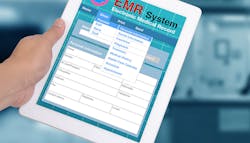On point, on record for closing the loop
Supply Chain consistently strives to control costs and expenses as much as possible, based in part on C-suite demands for the department’s functionality and role. One over-arching way to accomplish that is to know the organization’s total costs through tracking, tracing and linking to clinical, financial and patient care systems – one of which is the electronic health record/electronic medical record (EHR/EMR), where asset consumption and usage is (or should be) noted.
Imagine being able to apply supply and service consumption data to a single patient that extends to the item master and inventory management on one hand and to billing, reimbursement and revenue cycle on the other? That’s closing the loop.
Imagine Chevy Chase’s Clark Griswold character in “National Lampoon’s Christmas Vacation” connecting the elaborate house lights for the first time. If you remember that pivotal scene, you have a decent grasp of the healthcare supply chain’s universal link to EHR/EMR systems – not as widespread as it should be among healthcare organizations yearning to rein in costs, but plenty of room for illumination and improvement.
Standard interfloperability?
Short of an intricate (and dangerous) array of plug-in extenders dangling from the fuse box in the Griswold family garage, questions continue to linger as to why – nearly two decades after President George W. Bush created a sub-Cabinet position to promote national adoption and implementation of EHR/EMR systems that became a mandate a decade later – healthcare organizations are not farther along in the process.
Further, questions remain beyond simple adoption and implementation of EHR/EMR for patient and payer benefits – the clinical and revenue side of the financial component – but generally fall short of the expense side of the financial component.
What will it take for healthcare organizations to compare the challenges of linking Supply Chain systems to the EHR/EMR system versus the challenges of keeping them separate? Are the benefits of interfacing or integrating too operationally painful to endure or are the perceived benefits not yet worth the pain?
Supply Chain IT experts agree.
“Supply chain is the entry point not just of the ‘physical’ product; it is also the custodian of the ‘virtual’ item, the associated attributes, and the contracts that define the item cost,” Doner continued. “As a result, data needs to be accurate (connected to a source of truth), managed (kept updated throughout the chain of custody), and connected (shared) across the organization’s technology ecosystem.”
Doner posits that the problem may wrest within the systems themselves or even the data. But in the face of delivering quality patient care that should not be an excuse.
“Admittedly there are challenges to making this happen – systems don’t talk to each other in a common language, item identifiers are not consistent, data is not complete or accurate, item costs are variable, and the list goes on,” he noted. “Whatever the challenges are that we’ve identified, the risk to patient care, where we manage data independently within the operating silos of supply chain and the clinical enterprise, are far greater. The foundation of the Cost, Quality, and Outcomes [CQO] movement is compliance. Without seamless integration of data across the entire ecosystem you cannot control the point of entry for new items, record accurate procedural costs, drive clinician efficient at the point of care, or audit your clinical practice.”
“Unless and until both are addressed with the same amount of commitment, cost and revenue remain lopsided,” Muttin said. “It’s not a question of whether they should be integrated but when. If we believe a human body needs to be treated in its entirety for longevity, then in a similar way, the health of an organization will depend on treating the cost and revenue at the same time.”
Muttin points to cost-related data residing in multiple systems, such as order management and contract management, while other vital information concerning procedure, utilization per procedure, patient demographics and procedure outcomes are captured in the EMR/EHR. He lists six hurdles that complicate any necessary connectivity.
- Lack of data standardization: “Different software vendors provide these critical systems, so no shared data standards can be used to integrate the systems.”
- System integration: “While the ERP [enterprise resource planning] providers have been very open to publishing their data standards and APIs [application programming interfaces] to hook into their systems, the EMR/EHR vendors have been less receptive to this option. It remains difficult for third-party vendors to integrate systems.”
- Lack of in-house skill sets: “Even large IDNs have difficulty hiring and retaining top-level IT talent, so they often rely on third-party integrators. The situation is even more severe for smaller organizations, with neither skill nor budget.”
- Legacy systems: “Some hospitals are still using ERP or EMR/EHR systems that are behind firewalls, i.e., not on the cloud. In these situations, it becomes even more challenging to integrate the data, systems and processes.”
- Cost: “Even for some of the larger organizations, the cost of integration tends to be relatively high, and change management requires serious commitment.”
- Mindset and compliance: “We see an openness in supply chain management to integrate with the EMR/EHR systems but less so in the clinical and financial side. This may be due to keeping the revenue/reimbursement as ‘need to know’ or regulatory requirements.”
“Most of the time it comes down to challenges of technology, data standards, knowledge-skill set, FTE-time to build, maintain and monitor, and expense both internally from an ownership perspective or if you buy an annual managed service who implement and maintain the connections,” Amell indicated. “So many data and business processes efficiencies can be gained throughout day-to-day healthcare business operations and ultimately a positive effect on patient care and safety, to include not only patient safety, but caregiver safety. By understanding business process and defining a system of record up front, your data will be more consistent, you will reduce manual workarounds and be able to standardize and streamline work so that FTE times can be focused on providing value, not performing non-value-added tasks that could be automated.”
Amell envisions the ERP to serve as an organization’s supply chain, finance, and HR system of record and the EMR should be the clinical and patient system of record. For example, in Supply Chain the ERP should be the system of record for all product and product pricing information and should send that information to the EMR, keeping it updated with any add/changes and deletes, she notes. “Once that it is in place the product data in the EMR can be used on preference cards, patient charting, documentation and charging. This example is just the beginning of what can be done, and with today’s technology, we should be exchanging more and more data within these systems to support defined business processes,” she added.
“Interoperability among systems for master data is vital to supporting efficient and effective delivery of care as well as accurate charting and billing,” Lohkamp said. “As providers move their supply chain systems to the cloud, we see them taking advantage of this effort to link these systems to their EMR system to ensure that item master data and cost data is regularly sent over. This automation of master data ensures that both the ERP and the EMR have the same definition of an item and the same cost. In addition, any analytics that pull from either system will have a common definition.
“When these systems are separate, providers risk incomplete billing, inaccurate costing and more manual steps to reorder,” he added. “Closing the loop becomes much more difficult as data will need to be cleansed and standardized before analytics become useful.”
Chris Luoma, Senior Vice President, Global Product Management, GHX, urges looking at the big picture and backdrop of this IT connectivity. He posits that the average item master comprises about 70,000 SKUs.
Not surprisingly, when the ERP and EHR/EMR aren’t linked, they operate in silos so greater levels of data synchronization are required to ensure data integrity, according to Luoma. “The work is tedious and requires significant budget and staffing resources to mitigate the errors that arise from different data formats, multiple databases and many users,” he noted. “Additionally, a lack of standards like UDI [Unique Device Identification] prevents organizations from performing downstream analytics that require merged data sets, such as cost-per-procedure analysis.”
Luoma recognizes the need to move to a “value-based care model” but acknowledges that that requires an understanding of the true cost of care.
“We can’t do this efficiently, accurately or effectively with siloed data and unintegrated business processes,” he asserted. “Integrating systems helps ensure the integrity of the data feeding financial, operational and clinical systems and better align business processes. The long-term benefits outweigh the initial effort and investment of linking systems together.”
Risk versus reward
While Supply Chain IT experts acknowledge that the rewards and benefits of EHR/EMR systems integration far outweigh ignoring or postponing the actions, they also lament the challenges may be discouraging to some – not unlike dieting and/or working out to improve fitness and physique.
SupplyCopia’s Muttin recognizes the advantages of integrating the supply chain procurement to EMR/EHR as being so “huge” that he hails the strategy as the “holy grail of future organizations.”
With such connectivity, a healthcare organization can achieve five tenets, according to Muttin. They can:
- “Flawlessly implement a CQO process and integrate the stakeholders including supply chain, physicians, finance and contracting.”
- “Gain 360-degree visibility into every procedure cost, then tightly integrate patient outcomes with cost to proactively measure and manage both.”
- “Work with physicians to manage physician preference item costs, and even change physician behavior.”
- “Leverage a working platform and process model for increased visibility to spend and better demand management.
- “Deliver improved patient care,” he listed.
Prodigo Solutions’ Martin Doner applies a consumer-minded analogy to the process to illustrate the tension.
“Think of your frustration in the grocery store self-checkout line when you scan an item that the system does not recognize,” Doner noted. “Now translate that experience to healthcare. We should expect no less level of service when it comes to the accuracy of our ‘bill’ when it comes to the healthcare we receive.”
According to Doner, while price transparency may have been required for healthcare only a small percentage of hospitals were compliant with the Centers for Medicare and Medicaid Services (CMS) mandate. He cited a February 2022 report titled “Semi-Annual Hospital Price Transparency Compliance Report” from Patient Rights Advocate.org (https://www.patientrightsadvocate.org/semi- annual-compliance-report-2022).
“Every industry must know its costs to understand the relationship between the cost to deliver its goods and services and the price it sells those goods and services to its consumers,” he insisted.
But Doner quickly pivoted from blaming hospitals alone.
“Transparency is not wholly the responsibility of the provider,” he said. “This is an industry challenge, from product identification to complex pricing incentive programs built into contracts, to technology limitations around data management and the lack of industry-wide adoption of data standards. We all share responsibility to solve these industry challenges. These are not technical obstacles. We need to establish open channels for data to flow between the manufacturer and care provider, we need to be more transparent within supply channels to align supply with demand, we need to adopt standards which enable interoperability and reduce friction across the supply chain.”
“It is harder to connect clinical systems and operational systems such as Finance, HR and Supply Chain because there are no defined interoperability standards,” Schwarz said. He adds that “interoperability is well-defined in the clinical space,” citing Health Level 7 version 2 and Fast Healthcare Interoperability Resources (FHIR), and allowing for cross-community data exchange between different organizations with IHE XDS.B and the Trusted Exchange Framework and Common Agreement (TEFCA). “On the other hand, there are some [electronic data interchange] standards on the supply chain side, but there is no standard crosswalk between clinical and operation interoperability,” he added.
Schwarz encourages providers to develop use-cases that demonstrate the value of connecting the two worlds so that manufacturers of clinical systems and operational systems can build the necessary interfaces and provide insight into business operations and improved usability.
He foresees this connected world generating at least four specific benefits that enable providers to do the following:
- “Utilize clinical data as a predictor for supply needs. Many elective procedures are scheduled weeks in advance, so it is possible to utilize the data from the clinical system to inform the supply chain about required supplies.”
- “Deplete on-hand stock based on clinical data. Instead of dual data entry or manually tracking down supplies, activity recorded in the EMR can be utilized to re-stock supplies, while also preventing provider burnout from unnecessary clerical tasks.”
- “Predict workload and skills required for nursing staff based on clinical data – which helps to optimize resource allocations and provider satisfaction.”
- “Assess the actual cost of delivering a specific service/DRG by combining clinical data with financial and HR data for activity-based cost analysis. This allows not only root cause analysis of cost overruns, but it also allows providers to contract for bundled payments and risk/value-based models.”
Infor’s Melissa Amell also calls for “holistic product standards” to join interoperability standards. “Currently in today’s environment there are multiple standards, which contribute to variability and the lack of visibility in the healthcare supply chain,” she added.
The primary advantage of linking these systems is unlocking the value of data, according to GHX’s Chris Luoma.
“Data only serves the business when it is integrated into every business process across the care continuum and healthcare operations so that providers can make data-driven decisions aimed at balancing cost, quality and patient outcomes,” he indicated.
Adopting a “modern item data strategy” that links the ERP to the EHR/EMR will improve the order management process, making it more efficient by reducing waste and costs, Luoma notes.
“It helps ensure clinicians will have the items they need when they need them. And it can capture more charges in the revenue cycle because a complete record of items used at the point of care is synched with the EHR/EMR,” he said. “Further, this level of integration will help advance the evolution of care outside the four walls providing a data strategy foundation that will support demand for new supplies – in new, dispersed locations – as well as point-of-care systems that enable accurate capture and sharing of data.”
Yet Luoma acknowledges that securing the staffing resources and expertise to “build an item master that supports ‘just-in-time’ inventory for ERP systems and ‘just-in-case’ inventory for EHR/EMR systems remains a key barrier. This is why many providers are turning to data services organizations to support their integration efforts, he adds.
“Data services organizations curate information from a wide variety of sources – suppliers, providers, industry repositories such as GUDID, contract catalogs – and deliver the appropriate items with the appropriate attributes at the right point in time,” Luoma said. “Without question, integration of business processes requires a strong foundation of item data. And, as more hospitals move to a cloud-based ERP environment, they will need the ability to efficiently manage a massive body of data without having a team of 30+ experts managing item data. Given this, choosing a data service to support the depth and breadth of item management allows the investment in supply chain systems to serve as the source of truth and feed the EHR/EMR.”
Supply chain IT experts highlight effective EHR/EMR case studies, successful links
Healthcare Purchasing News invited several supply chain information technology experts with their fingers on the pulse of customer connectivity to share any insights about providers successfully linking supply chain to the electronic health record/electronic medical record systems within their organizations. Here’s what and who are making progress.
“With hospitals facing between $53 billion-$122 billion in losses due to lingering effects of COVID-19, there’s a renewed urgency among hospitals to improve operational efficiency, which has accelerated the move to cloud ERPs.
“Recently, GHX helped Bayhealth, central and southern Delaware’s largest healthcare system, move to a single cloud-based platform that integrates with supply chain and clinical systems. The access and visibility to unified data allows teams to work together to improve processes, identify waste and increase efficiency while never losing sight of the patient. To date, the organization has already seen big returns in clinical, financial and operational areas. For example, a nurse manager recently caught a pricing error with a GPO, and in less than 24 hours the supply chain team secured a $1 million pricing credit. The integrated environment not only provides for better planning but also allows teams to collaborate in identifying savings targets and reinvesting those funds for clinical needs.”
Chris Luoma, Senior Vice President, Global Product Management, GHX
[Editor’s Note: Bayhealth was named the 2021 SPD Department of the Year by Healthcare Purchasing News. See May 2021 HPN.]
“At Florence, SC-based McLeod Health, a seven-hospital system serving patients in 18 counties, a cross functional team want to create a clinically integrated supply chain. At the time, the team believed that cost and revenue existed as two separate islands in the organization. Leaders from supply chain, clinical and innovation came together to break through the siloes that separated data, people and processes.
“To measure patient outcomes more accurately and precisely, they hired an outside consulting company to provide HOOS and KOOS analysis. This analysis was included in the CQO. They brought physicians into discussions on overall cost management. They created a path to change physician behavior using an evidence-based system. They gained insights that helped manage the patient population, even in economically challenged regions, while continuing to serve patients and improve care.
“They designed a two-step integration strategy, while in the process of implementing several core systems. First, they leveraged a data warehouse to implement their CQO plan. Here, data was integrated that included cost, quality, outcomes, patient demographics, reimbursements. Second, a tight integration was created between their ERP and EMR/EHR systems. As a result, this team significantly improved both business and clinical performance.
Ashok Muttin, Founder and CEO, SupplyCopia
[Editor’s Note: McLeod Health earned Honorable Mention for the 2022 Surgical Performance Excellence in Supply Chain Award by Healthcare Purchasing News. See March 2022 HPN.]
“The leading healthcare supply chains are leveraging strong master data management practices along with technology to successfully link the supply chain systems to the EHR/EMR.
“Supply chain is part of your Value Analysis or Clinical Quality teams, so from the time the item is considered and approved for use, supply chain is gathering all the right data from manufacturers. Sourcing teams set data expectations during the contract phase so that manufacturers provide complete and accurate metadata attributes, packaging options (unit of measure and conversion factors), and pricing incentives that are transparent enough to calculate the right unit of use cost.
“Data enrichment adds item level taxonomy (UNSPSC, GMDN), implant/supply classification, and other item classification data is mapped to expense account/spend category to be used for charge code assignment and reporting. Device Identifiers (GTINs) are added at the package level to all clinical items that flow through to the EHR/EMR so items can be scanned and recorded on the patient record. Virtual Item Master is implemented to manage master data assets for all contract items throughout their lifecycle, integrating the item and contract price data to the ERP and downstream clinical systems.
“The benefit to is more efficient documentation (able to scan bar codes), more accurate cost capture (fewer missed items documented on the patient record), better clinical control of the procedural formulary (less variation, less risk from counterfeit items), easier audit and payment of supplier sales order (on bill-only orders), and improved revenue integrity (accurate reimbursement).”
Marlin Doner, Vice President, Data Analytics and Product Strategy, Prodigo Solutions
“We have developed a product that overcomes the lack of standardization with pre-made integrations, which allows our customers to combine and analyze data from their clinical and operational systems. Health systems, such as Bozeman in Montana, Confluence in Washington, or CHRISTUS Health in Texas are typical customers that use a variety of clinical and operational systems as well as our ready-made integrations for fast time-to-value deployment of integrations. The result is that supply depletion tracked in the clinical systems triggers automatic supply replenishment without the need for additional data input. Both clinical staff and supply analysts appreciate the integration between systems as easy and cost-effective to implement and operate.”
Joerg Schwarz, Director, Industry & Solution Strategy, Infor
“I was fortunate enough to work for a healthcare IDN early in my career that understood the value of data and how this integration standardized, automated, and streamlined business and clinical operations. It was something we built and maintained internally and had a bit of manual intervention in our process, but we made it work. In today’s environment, with the FTE shortage and most employees in healthcare performing multiple roles, I would do an assessment of current state within your organization to see if you have the structure (such as a dedicated, well-versed integration team) to support the building and maintenance of these integrations and then compare that to purchasing a service – companies that have prebuilt, preconfigured integrations to implement and maintain this data connection. Regardless, this is critical functionality to support and streamline operational business process within healthcare and is necessary for all supply chains that aspire to be fully clinically integrated.”
Melissa Amell, Director, Industry & Solution Strategy, Infor
“We’re seeing our provider customers leveraging this foundation of integrated data to better understand utilization and the cost to deliver care. Because of the common definition of data, providers can use blended analytics to combine EMR utilization data and supply chain costs to model costs and identify variations and opportunities to reduce variation and decrease costs.
“And it goes beyond just looking at what has already happened. One of our customers is building from the core integration of data between supply chain and EMR, and now loading in procedure cards for scheduled cases and comparing it to inventory to understand demand, identify potential shortfalls in supply and adjust sourcing plans.”
Keith Lohkamp, Senior Director, Industry Strategy, Workday
About the Author
Rick Dana Barlow
Senior Editor
Rick Dana Barlow is Senior Editor for Healthcare Purchasing News, an Endeavor Business Media publication. He can be reached at [email protected].







